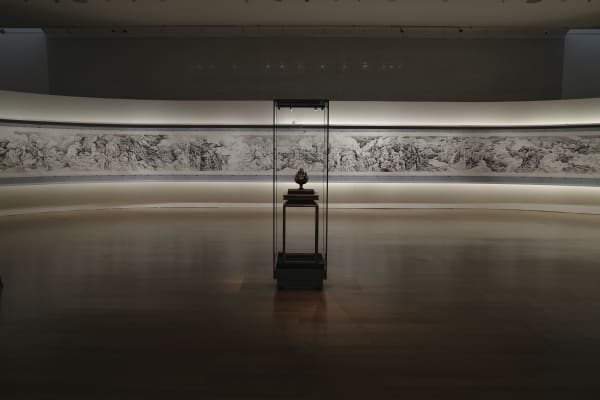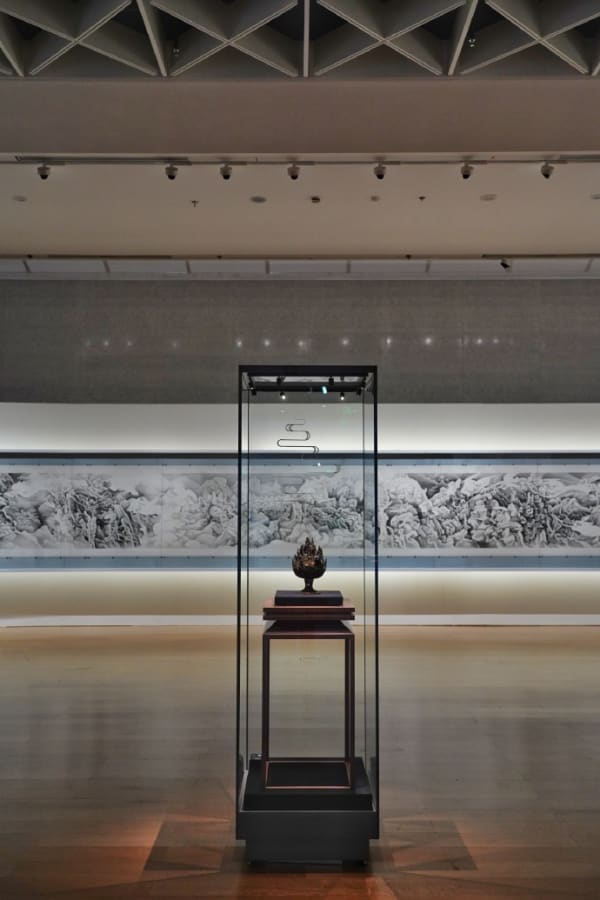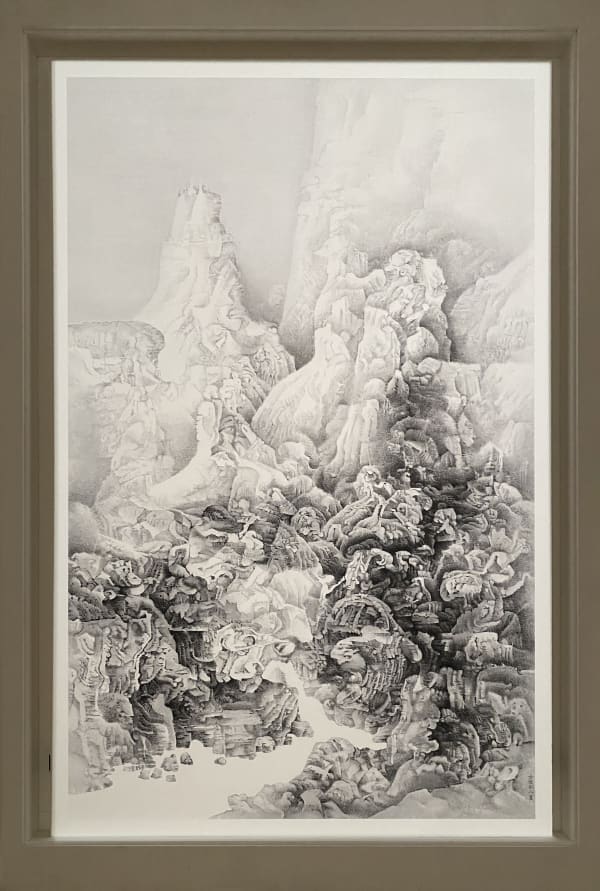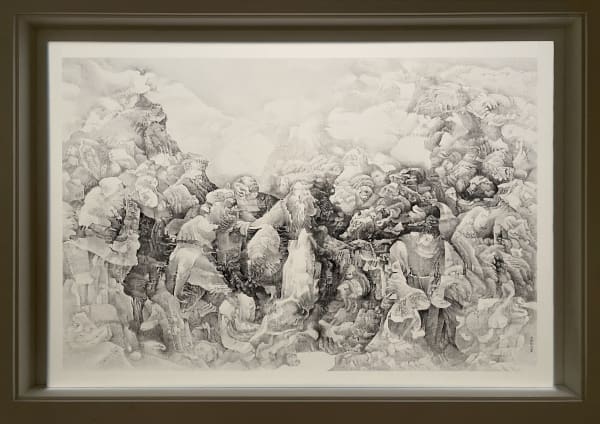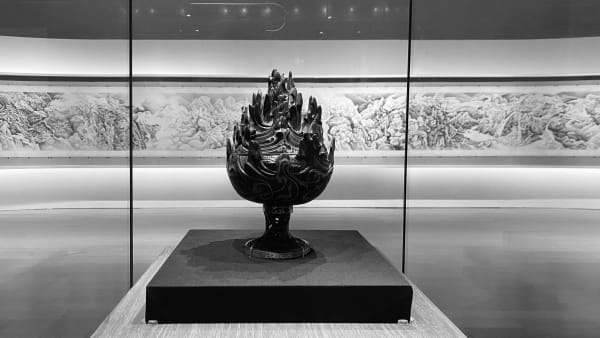Life and Belief: Art in the Han Dynasty
2024.12.15 - 2025. 3.9
Suzhou Museum
For this exhibition, we have especially invited the renowned contemporary artist Mr. Liu Dan to create a large-scale landscape scroll in response to ancient art and history. From the 70s of the 20th century, Liu Dan, in his creative process, started to contemplate the forms and elements of Han Dynasty art and explore spatial and temporal perceptions underlying the Landscape Painting. This awareness originates from his attention to the rite of “ spirit channeling” found in Han Dynasty art. He transforms the mountains and rivers metaphorically embodied by Bo Shan Incense Burner into transporting “landscapes”.
What comes to your mind when you think of the Han Dynasty? Is it the hyperbole that “The gale gains momentum, sweeping up the clouds”; or the heart throbbing verse of “ A fine lady from the northern country, her beauty unrivalled, her spirit independent”; or the melancholy sentiment aroused by “ The autumn wind blowing over the Han imperial mausoleums as well as the millet crops in the Han Zhong fields”? I believe each of us has our own favored bits of the Han Dynasty at heart.
As the Qin Dynasty came to an end, rivalry forces battled for the ultimate prize. Xiang Yu breached the agreement that “The imperial throne belongs to whoever storms the Qin imperial city first and brings it to capitulation ”. In steady, he made Liu Bang mere “Han Wang”, Ruler of Han. However, Xiao He suggested: “For thing, Han as in Celestial Han is wonderful for a title!” In ancient China, Han Shui(River) was a euphemism for the cosmic Milky Way, like “High up in the sky is the Han River, emanating bright light” from “ The Book of Songs”. From Han Shui(Han River), Han Zhong( Middle Han region), Han Wang( Ruler of Han), till eventually, Han became the name of a Dynasty. “Celestial Han” not only epitomized the cosmic ambition of Han Dynasty people, it has become synonymous with the identity of the majority of Chinese people since the Han Dynasty.
The Han Dynasty modeled its system after that of the Qin Dynasty. “Han kept the system of Qin, with modifications and additions”. In the early days of the Han Dynasty, the country was in shambles, waiting to be resurrected. As a result, the philosophy of Huang Di and Lao Zi was promoted, in order to give people a break and a chance to recover. Historians named this period “The Reign of Emperor Wen and Emperor Jin”, during which time and till the beginning of the rule of Emperor Wu Di, unfavorable domestic laws and regulations were gradually abolished; and national defense against foreign aggression was being built up. The motto was “Audacious foreign aggressors will be combated wherever they are.” Hence, a strong and powerful state emerged, laying the foundation for the survival of the Han Dynasty for the next 400 years.
The theme of the current exhibition is once more the Han Dynasty. But unlike our previous exhibition entitled “Restoration of Peace: the Four Faces of the Han Dynasty Civilization”, this exhibition focuses more on the daily life of the people of the Han Dynasty. Divided into two parts of “Life and Belief”, this exhibition endeavors, at different levels, to present the actual life of Han Dynasty people more than two thousand years ago. Even though the pottery objects excavated from Han Dynasty mausoleums like houses, wells, granaries, stoves, varieties of wine and water vessels, food containers, lamps and incense burners are models for burial purposes, they nevertheless give us a vivid portrayal of Han Dynasty people in everyday life over two thousand years ago: industrious, warm and well off. Objects such as Boshan Incense Burner, jade mask, wealth tree, exorcising vase, as well as objects depicting the belief of yin and yang and ascending immortals, reflect the cosmic universe in the imagination of Han Dynasty people and their understanding of life itself. These ideas, beliefs and philosophical concepts were infused in the blood of Han Dynasty people, forming the spiritual cells of the Chinese people in the two thousand years to come.
In addition, the exhibition also presents three large terracotta warrior and horses excavated respectively from the Yang Ling mausoleum of Emperor Han Jing Di, Yang Jia Wan of Xian Yang and Lion Mountain of Xu Zhou. Together, they reveal to us their unique yet complimentary artistic brilliance.
The stars in the sky spin and revolve in perpetual movement, creating a sense of genial eternity. The longing for a good life and the fantastic imagination about the celestial bodies shaped the Han Dynasty, the effect of which still touches us today. For more two thousand years, the quest for the “union of nature and man”, which is, the union of the cosmic sky, the earth and human life has not changed.
This exhibition has been made possible thanks to the rigorous support of Hebei Museum, Guangzhou Municipal Institute of Cultural Heritage and Archaeology, Chengdu Museum, Hanyangling Museum, Jiaozuo Museum, Mianyang Museum, Xianyang Museum, Xuzhou Museum, and Xuzhou Terracotta Warriors and Horses Museum, for which we express our heartfelt gratitude.
For more information, please refer to Suzhou Museum's website.
